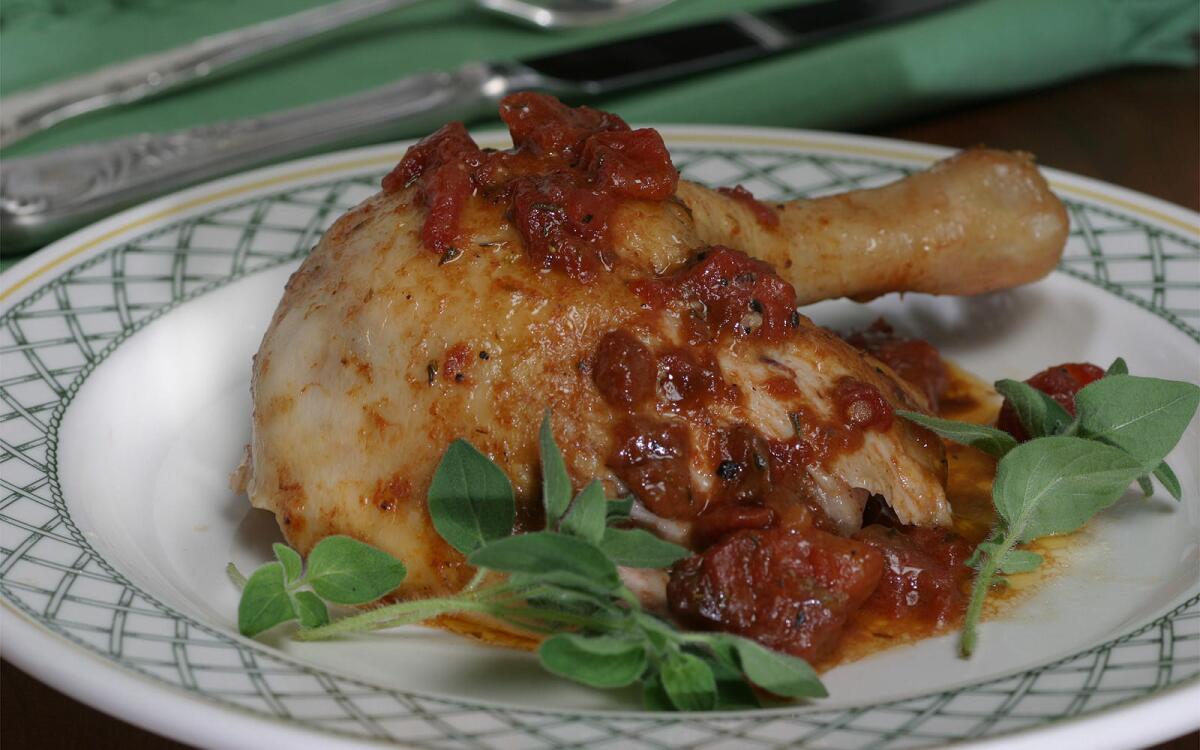Greek chicken

- Share via
Last month food writers from half a dozen countries went to London to remember Alan Davidson, the author of “The Oxford Companion to Food,” who died Dec. 2 at 79. The Feb. 19 memorial service was held a few blocks from his home, at Chelsea Old Church, a quaint 15th century building that still shows signs of the Nazi bombing of London during WWII.
Davidson was the pivotal figure in the growth of intellectually serious food writing in the last 25 years -- a prolific writer himself and the center of a worldwide network of food scholars. “If it weren’t for Alan Davidson’s vision in setting the stage and the standard for serious food writing,” says Darra Goldstein, editor of the journal Gastronomica, “culinary history would still be in the dark ages.”
But he had done more in his life than write about food. His first career was as a diplomat. It was while serving as British ambassador to Tunisia in 1963 that he started a long preoccupation with fish.
This might have had something to do with his family’s involvement in the fish trade in Scotland, but the direct inspiration was a question from his American-born wife, Jane, about the unfamiliar fish in Tunisian markets: For the use of foreigners in Tunis, could he write up a list of their names in all the languages spoken by the fishermen, along with some notes on how they were best cooked?
When he looked into the matter, he realized this would require writing a new sort of cookbook that would include a great deal of scientific and historical information. The idea seemed to energize him, possibly because it allowed his romantic, pioneering side to team up with the studious side that had won him a scholarship to Oxford. The mimeographed booklet came to the attention of English food writer Elizabeth David, and at her urging he brought out a fuller edition, “Mediterranean Seafood,” in 1972. The book, a recognized classic, is still in print; it was followed by “Seafood of Southeast Asia” (1977), “North Atlantic Seafood” (1979) and others.
Oddly, Davidson rarely cooked, except to make Scottish marmalade. His interest in food was as a consumer and scholar. As for the kind of food he liked, he tended to prefer the homely vernacular foods of all countries over haute cuisine.
In 1975, he took early retirement from the diplomatic service to become a full-time food writer. Four years later, he started Petits Propos Culinaires, a little quarterly magazine for quirky or scholarly articles about food that couldn’t find a place in commercial food magazines. The Davidsons published 63 issues out of their basement in the Chelsea neighborhood, known as the World’s End, before handing the job off to a friend.
Also in 1979, he co-founded the Oxford Symposium on Food, which attracts food scholars to St. Antony’s College, Oxford, every year. Though he was a bookish man, Davidson had a horror of academic writing and actively encouraged eager amateurs to contribute to the symposium. (In recent years, because of the number of papers submitted, the symposium has reluctantly had to limit the number presented, but it continues his non-academic approach.)
When he accepted the assignment to write “The Oxford Companion to Food,” he anticipated that it would take only a few years. It ended up taking about 18 years, and the manuscript grew so long that Oxford at one time considered publishing it in two volumes. When it finally came out in 1999, it went to the top of the Times Food Section’s best-seller list despite its $60 price tag. Some weeks it outsold “The Fannie Farmer Cookbook” on Amazon. Three years later a revised edition was issued in paperback as “The Penguin Companion to Food.”
After its publication, Davidson decided that after a quarter of a century, it was time to write about something else. Last March he visited L.A. to research a book on another favorite subject, American screwball comedies of the 1930s. He didn’t complete that book, but his decades of effort as a food writer were recognized in November, just a few weeks before his death, when the government of the Netherlands awarded him the prestigious Erasmus Prize for single-handedly elevating the study of food history to respectability.
At a Thai funeral, the family often hands out a pamphlet of the deceased’s favorite recipes. Davidson was charmed by this custom. “With what better keepsake could one depart from a funeral?” he once wrote. “What other would equally well keep one’s memory green among friends?”
Davidson’s family passed out such a booklet after his memorial service. He was an avid collector of old cookbooks, so the recipes did include an obscure 18th century dish of sauteed skate wing, but most were far more familiar -- one of his favorites was the meatloaf recipe from a Quaker Oats box. These were dishes his family had enjoyed repeatedly, so the recipes tended to be simple: Belgian-style fish gratin, homemade marmalade (the cover of the booklet showed the label he affixed to his marmalade jars), sauteed zucchini, Scottish-style trifle.
The effect was clearly what Davidson intended: intimate, easy-going, mildly eccentric and tasty. It will certainly keep his memory green.
Wash the chickens; pat dry. Combine the olive oil, 2 teaspoons of the salt and the lemon juice. Place the chickens in a roasting pan. Rub the oil mixture into the chickens, inside and out. Roast at 375 degrees for 1 hour.
Melt the butter in a medium saucepan. Add the tomatoes, the remaining 1 teaspoon of salt, the pepper and the oregano. Cook over medium-low heat, stirring occasionally, for about 5 minutes.
Pour the sauce over the chicken and reduce the oven to 350 degrees. Roast, basting frequently, until the chicken is tender, about 1 hour.
Get our Cooking newsletter.
Your roundup of inspiring recipes and kitchen tricks.
You may occasionally receive promotional content from the Los Angeles Times.















